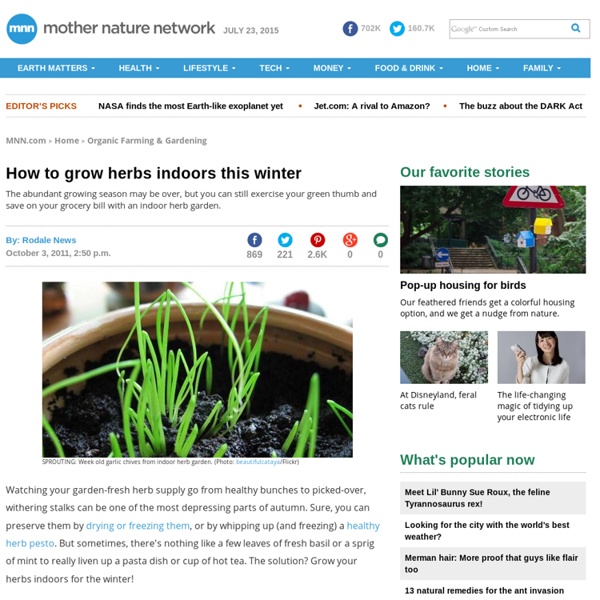10 Simple, Cheap Home Gardening Innovations to Set You on the Path to Food Independence
by Alex Pietrowski The issue of food quality and food independence is of critical importance these days, and people are recognizing just how easy and fun it is to grow your own food at home. When renegade gardener Ron Finley said, “growing your own food is like printing money,” he was remarking on the revolutionary nature of re-establishing control over your health and your pocket book as a means of subverting the exploitative and unhealthy food systems that encourage the over-consumption of processed and fast foods. Thanks to the Internet, the availability of parts and materials, and good old-fashioned ingenuity, there is a wide range of in-home, and in-apartment, gardening systems that are easy to construct and maintain, and that can provide nutritious, organic, and low-cost food for you and your family. Aquaponics Aquaponics is growing in popularity as a versatile method of growing nutritious vegetables while raising fish, combining hydroponic gardening with aquaculture.
Urban Gardening
Welcome! If you want to lose weight, gain muscle, increase energy levels or just generally look and feel healthier you've come to the right place. Here's where to start: Visit the Start Here and Primal Blueprint 101 pages to learn more about the Primal Lifestyle. Subscribe to my free weekly newsletter to receive 10 eBooks, a 7-Day Course of Primal Fundamentals, and more - all for free. Thanks for visiting! Those of us who live in larger cities value the diverse culture, the big-time arts and sports, the good job market, the easy travel access, and the many other lifestyle options city living provides. And this local news coverage of the family and their garden: Now that’s motivation and ingenuity. While the Dervaes family is truly exceptional, urban gardens (popular for decades in Europe) are taking off in a number of American cities these days. For more information on the Dervaes family and their project, check out their website, Path to Freedom.
10 Amazing Health Benefits of Turmeric
by Anna Hunt Delicious raw in smoothies or salad dressings, or as the savory orange spice behind the splendor of curry dishes, Turmeric is proving again and again to be one of the most beneficial and versatile natural health supplements one can take, and, it is surprisingly easily to grow. Turmeric, also known as Curcurma Longa, is related to the well-known ginger plant and also produces a rhizome that grows just beneath the ground. Its tall and brightly colored tropical green leaves are beautiful in the garden and commonly used in landscaping, but the rhizomes are harvested as food and medicine, or re-planted seasonally. To grow this beneficial plant this, one only needs a few rhizomes, a pot and a sunny place. Just place a small section of the rhizome an inch or two under the soil and water regularly. Turmeric is delicious in many recipes, and ideas for using it in the kitchen are easy to find. As Hippocrates said, “let food be thy medicine, and thy medicine be food.” Turmeric Products:
Moringa Oleifera: How to Plant, Grow, Cultivate Moringa Trees
What could be easier than walking into your yard, and gathering healthy leaves from your own grown Moringa plants to put on the table? Moringa is a fast-growing, drought resistant tree The moringa tree is a plant that grows mainly in semiarid, subtropical areas. While Moringa grows best in dry, sandy soil, it tolerates poor soil. The Moringa tree can grow to about 10 meters tall, with drooping branches.
Coffee Grounds for Plants, Used or Fresh and How Much
Coffee – Gramma always said, “Coffee is the elixer of life”. Grampa always said, “Coffee Grounds are the elixer of life in my garden”. If you drink coffee, you know it leaves us with a wonderful by-product, coffee grounds. You may also know used coffee ground for plants in the garden does several beneficial things. Fresh or unused coffee grounds can be used in the garden. Coffee grounds contain nitrogen, calcium, magnesium, phosphorus, potassium, and trace amount of minerals including copper. The earthworms and worms of all types love the grounds as they provide food for them. Adding coffee grounds to the compost pile increases the internal temperature of the pile, it heats up. Coffee grounds for plants as a fertilizer is a common practice. The acid loving plants are the ones that will thank you for a dose of coffee grounds, especially blueberries and evergreen plants. Exactly what is acidic soil? Common Acidic Loving Herbs: (some herbs can be in more than one category) Happy Gardening!
Learn to Grow Plants and Food With Beginner Garden Projects
@Scott Gardner: Head over to Cornell university's web site for everything you need to know about specific plants. They'll give you the soil requirements, optimum amounts of light, soil temperatures, watering schedule etc for most of your basic garden plants. Next, review your soil condition. Soil consistency is also very important. There are a million gardening books on BitTorrent and NewsGroups, ranging from the Idiot's guides, to the required texts for doctoral studies in agriculture and biochemistry. YouTube, Instructables, HowCast and other how-to sites will walk you through pretty much everything. Contact your extension office, they'll give you tips relative to your geographic location. Remember, you don't need to stop at Vegetables. Good luck.



